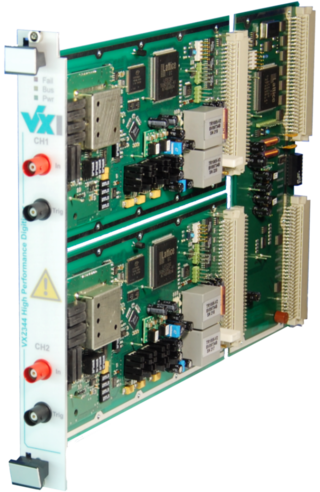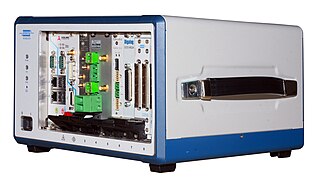This article contains content that is written like an advertisement .(March 2024) |
LAN eXtensions for Instrumentation (LXI) is a standard which defines the communication protocols for instrumentation and data acquisition systems using Ethernet. [1]
This article contains content that is written like an advertisement .(March 2024) |
LAN eXtensions for Instrumentation (LXI) is a standard which defines the communication protocols for instrumentation and data acquisition systems using Ethernet. [1]
Proposed in 2005 by Keysight [2] and VTI Instruments, [3] the LXI standard adapts the Ethernet and World Wide Web standards to test and measurement applications. [4] The standard defines how existing standards should be used in instrumentation applications to provide a consistent feel and ensure compatibility between equipment.
The LXI standard does not define a mechanical format. LXI products can be modular, rack mounted, bench mounted or take any other physical form. LXI products may have no front panel or display, or they may include embedded displays and keyboards.
Use of Ethernet allows instrument systems to be spread over large distances. An optional Extended Function based on IEEE 1588 Precision Timing Protocol allows instruments to communicate on a time basis, initiating events at specified times or intervals and time stamping events to indicate when these events occurred. [5]
LXI devices can coexist with Ethernet devices that are not themselves LXI compliant. They can also be present in test systems which include products based on the GPIB, VXI, and PXI standards.
The standard mandates that every LXI instrument must have an Interchangeable Virtual Instrument (IVI) driver. The IVI Foundation defines a standard driver application programming interface (API) for programmable instruments. IVI driver formats can be IVI-COM for working with COM-based development environments and IVI-C for working in traditional programming languages for use in a .NET Framework.
Most LXI instruments can be programmed with methods other than IVI, so it is not mandatory to work with an IVI driver. Developers can use other driver technologies or work directly with SCPI commands.
The LXI Standard has three major elements:
The specification is organized into a set of documents which describe:
In 2005, the LXI Consortium released Version 1.0 of the LXI Standard. [6] Version 1.1 followed with minor corrections and clarifications. In 2007, the Consortium adopted Version 1.2; its major focus was discovery mechanisms. Specifically, LXI 1.2 included enhancements to support mDNS discovery of LXI devices. Version 1.3 incorporates the 2008 version of IEEE 1588 for synchronizing time among instruments. As of November 2016, the standard is at Revision 1.5.
The LXI Consortium requires LXI Devices to go through standard testing.
To support this compliance regime an LXI Test Suite is available. After a vendor joins the LXI Consortium they can gain access to the Consortium's Conformance Test Suite software, which they can use as a pre-test before submitting the product to the Consortium for compliance testing. Once a product is ready to submit, a vendor can choose to have their product tested at a PlugFest or an approved test house. A Technical Justification route allows vendors to certify compliance of derivative products by submitting test results to the Consortium to show that the device has been tested on the LXI Test Suite. The consortium provides guidance on when the Technical Justification route can be used and when a new formal test is required.

IEEE 488, also known as HP-IB and generically as GPIB, is a short-range digital communications 8-bit parallel multi-master interface bus specification developed by Hewlett-Packard. It subsequently became the subject of several standards.

Electronic test equipment is used to create signals and capture responses from electronic devices under test (DUTs). In this way, the proper operation of the DUT can be proven or faults in the device can be traced. Use of electronic test equipment is essential to any serious work on electronics systems.

VME eXtensions for instrumentation bus refers to standards for automated test based upon VMEbus. VXI defines additional bus lines for timing and triggering as well as mechanical requirements and standard protocols for configuration, message-based communication, multi-chassis extension, and other features. In 2004, the 2eVME extension was added to the VXI bus specification, giving it a maximum data rate of 160 MB/s.

Automatic test equipment or automated test equipment (ATE) is any apparatus that performs tests on a device, known as the device under test (DUT), equipment under test (EUT) or unit under test (UUT), using automation to quickly perform measurements and evaluate the test results. An ATE can be a simple computer-controlled digital multimeter, or a complicated system containing dozens of complex test instruments capable of automatically testing and diagnosing faults in sophisticated electronic packaged parts or on wafer testing, including system on chips and integrated circuits.
The Precision Time Protocol (PTP) is a protocol used to synchronize clocks throughout a computer network. On a local area network, it achieves clock accuracy in the sub-microsecond range, making it suitable for measurement and control systems. PTP is employed to synchronize financial transactions, mobile phone tower transmissions, sub-sea acoustic arrays, and networks that require precise timing but lack access to satellite navigation signals.
Keysight VEE is a graphical dataflow programming software development environment from Keysight Technologies for automated test, measurement, data analysis and reporting. VEE originally stood for Visual Engineering Environment and developed by HP designated as HP VEE; it has since been officially renamed to Keysight VEE. Keysight VEE has been widely used in various industries, serving the entire stage of a product lifecycle, from design, validation to manufacturing. It is optimized in instrument control and automation with test and measurement devices such as data acquisition instruments like digital voltmeters and oscilloscopes, and source devices like signal generators and programmable power supplies.
Virtual instrument software architecture (VISA) is a widely used application programming interface (API) in the test and measurement (T&M) industry for communicating with instruments from a computer. VISA is an industry standard implemented by several T&M companies, such as, Anritsu, Bustec, Keysight Technologies, Kikusui, National Instruments, Rohde & Schwarz, and Tektronix.

PCI eXtensions for Instrumentation (PXI) is one of several modular electronic instrumentation platforms in current use. These platforms are used as a basis for building electronic test equipment, automation systems, and modular laboratory instruments.
Instrument control consists of connecting a desktop instrument to a computer and taking measurements.

The Standard Commands for Programmable Instruments defines a standard for syntax and commands to use in controlling programmable test and measurement devices, such as automatic test equipment and electronic test equipment.
Sercos III is the third generation of the Sercos interface, a standardized open digital interface for the communication between industrial controls, motion devices, input/output devices (I/O), and Ethernet nodes, such as PCs. Sercos III applies the hard real-time features of the Sercos interface to Ethernet. It is based upon the Ethernet standard. Work began on Sercos III in 2003, with vendors releasing first products supporting it in 2005.
M-Modules are a mezzanine standard mainly used in industrial computers. Being mezzanines, they are always plugged on a carrier printed circuit board (PCB) that supports this format. The modules communicate with their carrier over a dedicated bus, and can have all kinds of special functions.
AdvancedTCA Extensions for Instrumentation and Test (AXIe) is a modular instrumentation standard created by Aeroflex, Keysight Technologies, and Test Evolution Corporation. (In October 2008, Aeroflex had purchased a 40% shareholding in Test Evolution.)
An instrument driver, in the context of test and measurement (T&M) application development, is a set of software routines that simplifies remote instrument control. Instrument drivers are specified by the IVI Foundation and define an I/O abstraction layer using the virtual instrument software architecture (VISA). The VISA hardware abstraction layer provides an interface-independent communication channel to T&M instruments. Furthermore, the instrument drivers encapsulate the Standard Commands for Programmable Instruments (SCPI) commands, which are an ASCII-based set of commands for reading and writing instrument settings and measurement data. This standard allows an abstract way of using various programming languages to program remote-control applications instead of using SCPI commands. An instrument driver usually has a well-defined API.
Bustec is a company that designs and manufactures instrumentation for high-performance data acquisition and instrument control. The company's products serve applications that include engine testing, automotive and missile testing, wind tunnel data acquisition and control, acoustics, vibration applications, aircraft component testing and more. Headquarters is located in Shannon, Co. Clare, Ireland.
HiSLIP is a TCP/IP-based protocol for remote instrument control of LAN-based test and measurement instruments. It was specified by the IVI Foundation and is intended to replace the older VXI-11 protocol. Like VXI-11, HiSLIP is normally used via a library that implements the VISA API. Version 1.4 of the LAN eXtensions for Instrumentation (LXI) standard recommends HiSLIP as “LXI HiSLIP Extended Function for LXI based instrumentation”.
In the electronics industry, embedded instrumentation refers to the integration of test and measurement instrumentation into semiconductor chips. Embedded instrumentation differs from embedded system, which are electronic systems or subsystems that usually comprise the control portion of a larger electronic system. Instrumentation embedded into chips is employed in a variety of electronic test applications, including validating and testing chips themselves, validating, testing and debugging the circuit boards where these chips are deployed, and troubleshooting systems once they have been installed in the field.

The OPEN Alliance is a non-profit, special interest group (SIG) of mainly automotive industry and technology providers collaborating to encourage wide scale adoption of Ethernet-based communication as the standard in automotive networking applications.
Avnu Alliance is a consortium of member companies working together to create an interoperable ecosystem of low-latency, time-synchronized, highly reliable networking devices using the IEEE open standard, Time-Sensitive Networking (TSN) and its Pro AV networking protocol, Milan. Avnu Alliance creates comprehensive certification programs to ensure interoperability of network devices. In the Professional Audio Video (AV) industry, Alliance member companies worked together to develop Milan: a standards-based, user-driven deterministic network protocol for professional media, that through certification, assures devices will work together at new levels of convenience, reliability, and functionality. Milan™ is a standards-based deterministic network protocol for real time media. Avnu Members may use the Avnu-certified or Milan-certified logo on devices that pass the conformance tests from Avnu. Not every device based on AVB or TSN is submitted for certification to the Avnu Alliance. The lack of the Avnu logo does not necessarily imply a device is incompatible with other Avnu-certified devices. The Alliance, in conjunction with other complimentary standards bodies and alliances, provides a united network foundation for use in professional AV, automotive, industrial control and consumer segments.
AES67 is a technical standard for audio over IP and audio over Ethernet (AoE) interoperability. The standard was developed by the Audio Engineering Society and first published in September 2013. It is a layer 3 protocol suite based on existing standards and is designed to allow interoperability between various IP-based audio networking systems such as RAVENNA, Livewire, Q-LAN and Dante.